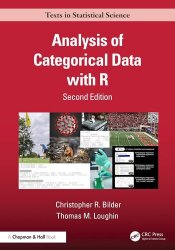 Название: Analysis of Categorical Data with R, 2nd Edition
Название: Analysis of Categorical Data with R, 2nd EditionАвтор: Christopher R. Bilder, Thomas M. Loughin
Издательство: CRC Press
Год: 2025
Страниц: 688
Язык: английский
Формат: epub (true)
Размер: 10.1 MB
Analysis of Categorical Data with R, Second Edition presents a modern account of categorical data analysis using the R software environment. It covers recent techniques of model building and assessment for binary, multicategory, and count response variables and discusses fundamentals, such as odds ratio and probability estimation. The authors give detailed advice and guidelines on which procedures to use and why to use them.
The second edition is a substantial update of the first based on the authors’ experiences of teaching from the book for nearly a decade. The book is organized as before, but with new content throughout, and there are two new substantive topics in the advanced topics chapter—group testing and splines. The computing has been completely updated, with the "emmeans" package now integrated into the book. The examples have also been updated, notably to include new examples based on COVID-19, and there are more than 90 new exercises in the book. The solutions manual and teaching videos have also been updated.
Features:
Requires no prior experience with R, and offers an introduction to the essential features and functions of R
Includes numerous examples from medicine, psychology, sports, ecology, and many other areas
Integrates extensive R code and output
Graphically demonstrates many of the features and properties of various analysis methods
Offers a substantial number of exercises in all chapters, enabling use as a course text or for self-study
Supplemented by a website with data sets, code, and teaching videos
The book is organized in the same manner as the first edition. Chapters 1–4 examine categorical data analysis by response type: binary (Chapters 1–2), multicategory (Chapter 3), and count (Chapter 4). Chapter 5 unifies the previous chapters by examining model building techniques and diagnostic methods, while also providing two case studies. Chapter 6 explores more advanced topics important to categorical data analysis. Some of these topics are for specialized forms of data, while others provide alternative tools for analysis. We anticipate that an instructor for a one-semester course will be able to cover most of Chapters 1–5 and choose additional topics from Chapter 6 as desired.
Our additional exercises go beyond applications to data. We include more Monte Carlo simulation-based exercises to help readers learn abstract concepts. Exercises also include extensions of the content within the main text, like writing R functions to make coding more efficient, exploring other R packages, and implementing alternative statistical methods. We provide step-by-step guidance with these types of exercises. Not all new exercises involve R. We include exercises that allow readers to derive expressions to help reinforce topics discussed in the main text.
The book does not require any prior experience with R. We provide an introduction to the essential features and functions of R in Appendix A. We also provide introductory details on the use of R in the earlier chapters to help inexperienced R users. Throughout the book, as new R functions are needed, their basic features are discussed in the text and their implementation shown with corresponding output. We focus on using R packages that are provided by default with the initial R installation. However, we make frequent use of other R packages when they are significantly better or contain functionality unavailable in the standard R packages. The book contains the code and output as it would appear in the R Console; we make minor modifications at times to the output only to save space within the book. Code provided in the book for plotting is often meant for color display rather than the actual black-and-white display shown in the print and some electronic editions.
Analysis of Categorical Data with R, Second Edition is primarily designed for a course on categorical data analysis taught at the advanced undergraduate or graduate level. Such a course could be taught in a statistics or biostatistics department, or within mathematics, psychology, social science, ecology, or another quantitative discipline. It could also be used by a self-learner and would make an ideal reference for a researcher from any discipline where categorical data arise.
Скачать Analysis of Categorical Data with R, 2nd Edition